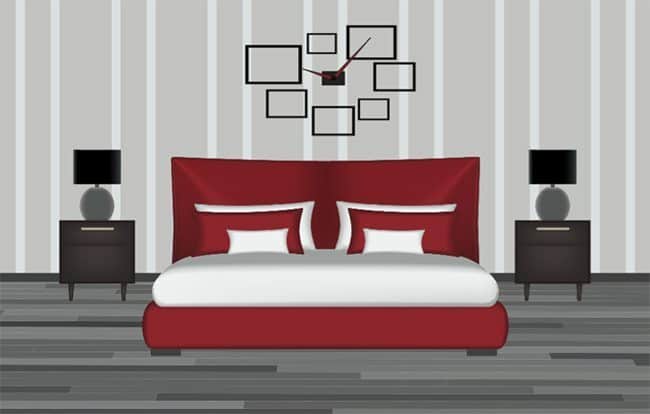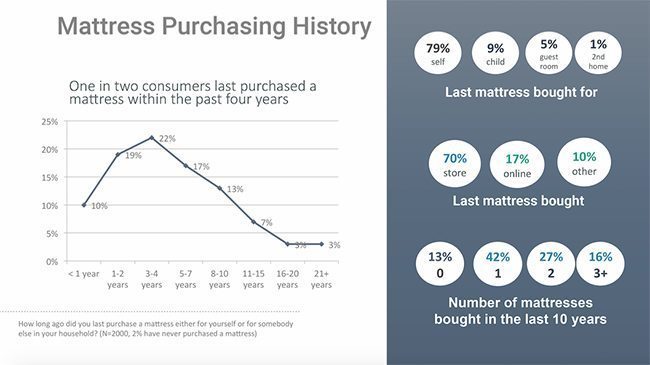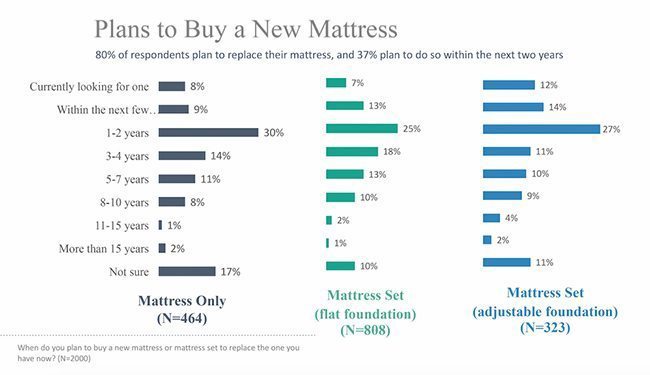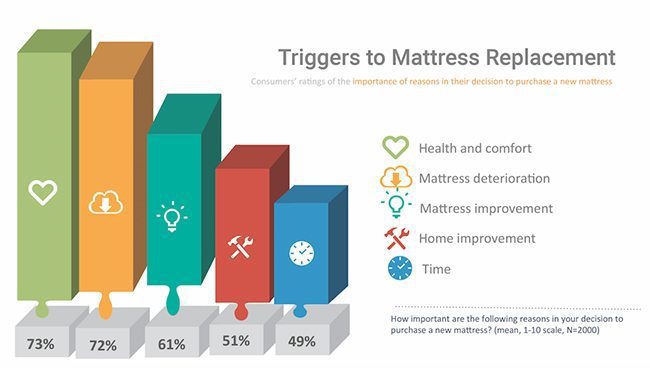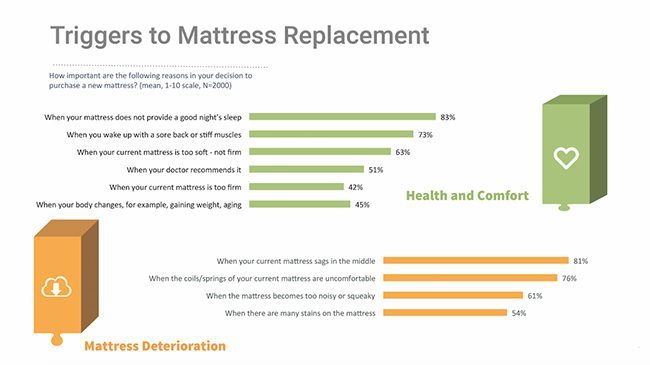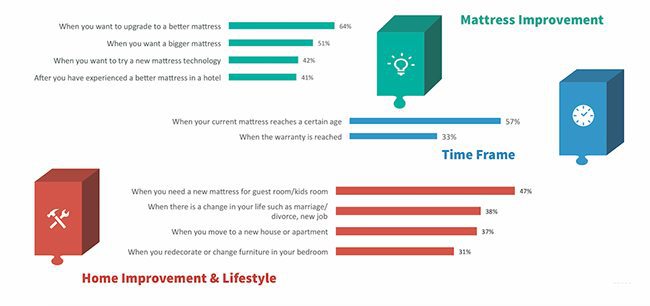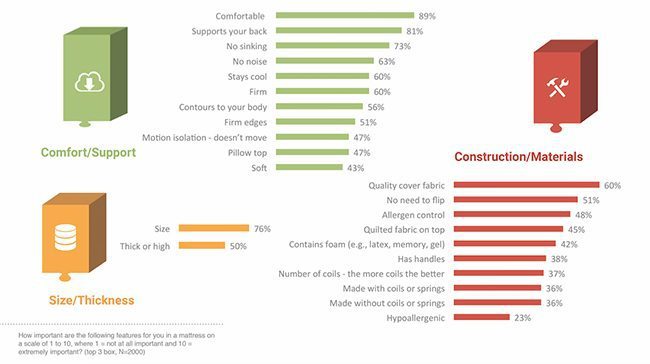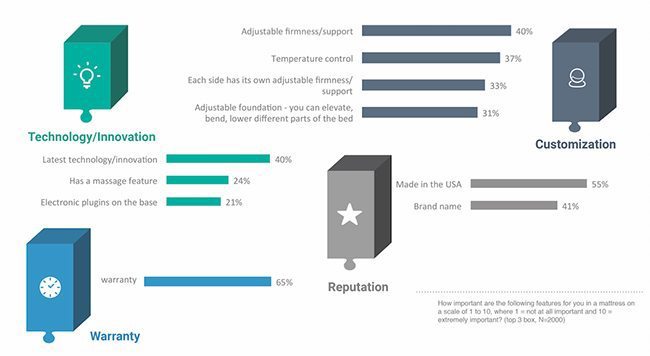Exclusive Better Sleep Council Research
A 2016 study from the Better Sleep Council, the consumer-education arm of the International Sleep Products Association, discovers shoppers are satisfied with their current mattresses but many are on the lookout to replace them in a few years
Want some good news to kick off the new year? How about this: Consumers are generally quite satisfied with the key product of the sleep products industry—the mattress.
Want more good news? Although they’re content with their current sleep set, consumers are keenly aware of and interested in new bedding technologies and many expect to shop for a new bed in the next few years, often to take advantage of those new features even before their current bed starts to wear out, according to research conducted by New York-based Fluent Research on behalf of the Better Sleep Council, the consumer-education arm of the International Sleep Products Association.
Now, doesn’t that make you feel better about starting 2017?
The BSC has been conducting comprehensive quantitative and qualitative consumer research since 1996, all with a goal “to inform the communications strategy of the (sleep products) industry so that it can educate consumers regarding the health benefits of sleeping on a quality mattress and the importance of regular mattress replacement,” according to a report from New York-based Fluent Research accompanying the latest survey results. The most recent consumer research, conducted in 2016 and released at the end of the year, shows the industry is, indeed, making progress when it comes to educating consumers about the benefits of and latest innovations in its primary products.
Satisfied but ready to shop
Some of the most encouraging news found in the latest research shows that people generally like their mattresses, with about eight in 10 consumers reporting they are satisfied with their current mattress (43% are “very satisfied”; 38% “somewhat satisfied”). Also heartening: Just 14% of survey respondents report being dissatisfied with their current bed (7% “somewhat dissatisfied”; 4% “very dissatisfied”). The remaining 8% report “neutral” feelings about their current sleep set.
Some of that satisfaction may come from the fact that nearly half of respondents are sleeping on relatively new mattresses, with 49% having bought a mattress for themselves in the past four years. Another 32% are sleeping on a mattress that’s five to 10 years old, with just 15% sleeping on a bed they’ve have for more than 11 years. Not unexpectedly, 79% of all survey respondents say their last mattress purchase was for themselves. Others were bought for a child (9%), guest room (5%) and second home (1%).
When it comes to size, bigger is definitely better among today’s consumers. Nearly half (47%) currently sleep on a queen-size mattress and nearly a third sleep on a king (25% traditional king; 7% California king). Far fewer sleep on the smaller sizes—15% on a full and 6% on a twin.
More traditional mattress constructions dominate today’s bedrooms, with 30% of consumers describing their current mattress as a “pillow-top” and 27% saying they sleep on a “spring mattress.” But specialty bedding has made significant inroads, with nearly a third of people sleeping on other bedding types, including foam-only mattresses (16%), hybrid mattresses (10%) and airbeds (6%).
In other news that should buoy both mattress makers and retailers, although they are largely satisfied with their current mattress, more than a third of consumers (37%) have plans to go bed shopping within the next two years: 6% currently are shopping for a new mattress, 10% plan to do so in the next few months and 21% say they will replace their mattress in one to two years.
But some survey respondents say they are operating on a longer time frame—12% report they’ll be in the market for a new bed in three to four years, 9% in five to seven years and 7% in eight to 10 years. And then there are the 2% that think they might buy a new mattress in 11 to 15 years and the 1% that have mattress-shopping plans more than 15 years in the future. (Something to ponder: Are those folks planning far, far ahead or just putting off the task?)
When it’s time to pull replacement trigger
It doesn’t seem to be one single thing that convinces consumers it’s time for a new mattress, but rather a constellation of factors, according to the BSC research.
Factors that are clustered around three main causes—health/comfort, mattress deterioration and mattress improvement—appear most often to trigger the decision to replace a mattress, with nearly three-quarters of respondents pointing to at least one factor related to those issues as a reason they would purchase a new mattress, the research shows. The question was phrased: “How important are the following reasons in your decision to purchase a new mattress?”
Specific factors related to health/comfort that were mentioned in the survey include:
- When your mattress does not provide a good night’s sleep (83% of respondents cited this as a very important reason for mattress replacement)
- When you wake up with a sore back or stiff muscles (73%)
- When your current mattress is too soft (not firm) (63%)
- When your doctor recommends it (51%)
- When your body changes (for example, gaining weight) (45%)
- When your current mattress is too firm (42%)
As a respondent identified as Doreen said, “One day, I mentioned to a friend I was waking up every day with a sore back. She asked how old my mattress was and when I told her it was about 10 years old, she said that was my problem. It hadn’t dawned on me till that moment that I needed a new mattress. I did research and found out my mattress was past its prime, so I bought a new one.”
Specific factors related to mattress deterioration mentioned in the survey include:
- When your current mattress sags in the middle (81% rated this as a very important reason to purchase a new mattress)
- When the coils/springs of your current mattress are uncomfortable (76%)
- When the mattress becomes too noisy or squeaky (61%)
- When there are many stains on the mattress (54%)
Other important factors triggering people to decide it’s time for a new mattress are bunched around the idea that consumers can make an improvement over their current mattress by purchasing a new one.
Specific factors related to mattress improvement that were mentioned in the survey include:
- When you want to upgrade to a better mattress (64% say this is a very important reason to purchase a new mattress)
- When you want a bigger mattress (51%)
- When you want to try a new mattress technology (42%)
- After you have experienced a better mattress in a hotel (41%)
Slightly less important to respondents, overall, were matters related to time frame, such as the age of their current mattress, and home improvement, such as moving to a new home.
Choice is great, but can be confusing
Consumers, the BSC research shows, are aware of and appreciate the fact that they have more choice in mattress constructions and types than ever before. As one respondent said, “Yes, there is a lot more to choose from now as new materials and styles are invented. It gives you a wide range to choose from. It affects my decision making by always wanting the latest and greatest.”
In fact, 85% of respondents said they agree (50% strongly agree) with the statement, “Today, there is a great variety of mattresses available for every taste.”
But all that choice comes with a few drawbacks as some consumers report feeling overwhelmed and baffled by all the choices and thus feel a need to do extensive research before making a purchase.
“Absolutely, we have more choices than even not too long ago,” one respondent said. “…The impact this has had on my shopping has been that I want to look at all types before I decide on a new mattress, and the research takes a lot longer than it used to. A bed is a huge investment, not only in money, but also in quality of life since we spend so much time on it. I want to make sure I make a good decision, and that’s not an easy task with all the choices out there.”
Or, as another respondent put it, “While the selections have increased, so has the confusion. Every store has a cutaway and theirs is the best. Even the same manufacturer has made the same product with different names for different stores and outlets so you can’t really do a heads-to-head comparison like you can with a car.”
Such comments point to a need for both mattress manufacturers and retailers to find new ways to clearly differentiate features and benefits of bed sets—both in-store and online—in a way that consumers can easily understand and use for comparison.
When it comes to mattress types, consumers voice a preference for pillow-tops, but not by wide margins, as several other constructions also find favor. When asked, “In your opinion, which technology is best suited for a good mattress today?” 33% of respondents cited pillow-top mattresses. But 23% prefer foam-only mattresses and 21% favor hybrids. Another 14% say a “spring mattress” is the best sleeping surface and 10% chose “adjustable air chamber.” Earning responses in the single digits were waterbeds (5%), sleeper sofas (4%) and futons (4%). (Respondents could choose more than one answer.)
Among consumers who prefer foam (either foam-only or hybrid mattresses with foam and springs), memory foam is most popular, with 62% saying it is “best suited for a good mattress.” Another 18% favor gel and 15% prefer latex. This isn’t surprising given that memory foam defined the category early on and remains the premium foam offering from most mattress manufacturers and retailers.
A lot goes into a ‘quality’ mattress
When it comes to evaluating a mattress as a quality product that they’d want to buy, consumers consider a host of factors, according to the BSC research. Most important to consumers are items related to comfort/support, construction/materials and size/thickness. The survey asked, “How important are the following features for you in a mattress on a scale of 1 to 10, where 1 = not at all important and 10 = extremely important?”
Specific factors related to a mattress’ comfort/support that were mentioned in the survey include:
- Comfortable (89% of consumers rate this as a very important quality or feature in a mattress)
- Supports your back (81%)
- No sinking (73%)
- No noise (63%)
- Stays cool (60%)
- Firm (60%)
- Contours to your body (56%)
- Firm edges (51%)
- Motion isolation (doesn’t move) (47%)
- Pillow-top (47%)
- Soft (43%)
Consumers rated the following features related to a mattress’ construction/materials as very important:
- Quality cover fabric (60%)
- No need to flip (51%)
- Allergen control (48%)
- Quilted fabric on top (45%)
- Contains foam (such as latex, memory or gel) (42%)
- Has handles (38%)
- Number of coils (the more coils the better) (37%)
- Made with coils or springs (36%)
- Made without coils or springs (36%)
- Hypoallergenic (23%)
Specific factors related to a mattress’ size/thickness that were mentioned in the survey include:
- Size (76%)
- Thick or high (50%)
Respondents to the survey also considered items such as a mattress brand’s reputation, warranty, customization options, and technology/innovation. For more details on how consumers believe these factors are related to a mattress’ quality, see the charts below.
Adjusting to the idea of adjustables
The sleep products industry’s efforts to explain the benefits of adjustable bed bases to consumers have had a positive effect. According to the research, 9% of consumers own an adjustable base and another 33% say they are familiar with the product and would consider buying one.
“I am aware of the adjustable bed frames,” says a respondent identified as Kelly. “I think it is good if you watch TV in your bedroom to sit up, or for people with breathing or other issues that need the bed adjusted.”
Still, plenty of consumers need more persuasion: 26% say although they are familiar with adjustable foundations, they have no interest in purchasing one.
Consumer interest in adjustable bed bases—which not only help alleviate health issues like snoring and back pain but make it easier for people to read, watch TV and even work in bed as respondent Kelly indicated—makes sense when we look how survey respondents view their bedrooms. Some 48% look at their bedroom as a utilitarian space, describing it as “just a place to sleep.” But the majority of people see their bedroom quite differently. A respondent identified as Rosanna represents the 25% of people who call their bedroom a “sanctuary”—a concept promoted by the BSC for optimal rest and relaxation. As Rosanna said about her space: “My favorite room in the house! I keep my bedroom very minimal and free of distractions. My bedroom is for sleeping and I’ve designed it in a way that promotes that. The room is in a very neutral color, lots of comfy pillows and I splurge on 750-thread-count sheets. No TVs or electronics. I keep books around my nightstand, a candle for relaxation and some artwork.”
Another 19% of consumers describe their bedroom as “an all-purpose room where I sleep, work, go online” and 7% use their bedroom as a family room where everyone gathers.
More survey results
BedTimes first delved into the results of the Better Sleep Council’s consumer research in the December 2016 feature, “What Motivates Today’s Mattress Shopper,” which looked at how consumers are replacing their mattresses more often than in the past and expecting to pay more when they do. We also examined consumers’ preferences when it comes to product research and shopping channels. But there is plenty to report. We’ll do a final installment in the February issue of the magazine, looking in-depth at what consumers think about the role of sleep in their lives, how they shop for sleep products accessories and more.
Survey methodology
Since 1996, the Better Sleep Council, the consumer-education arm of the International Sleep Products Association, has conducted research to better understand and track changes in consumers’ attitudes toward sleep and health, their decision-making process with regard to mattress purchases, and their shopping preferences and habits when it comes to sleep sets and related products.
As in past rounds of research, the 2016 study used a combination of quantitative and qualitative methodologies. Specifically, the latest research was carried out by New York-based Fluent Research and included three phases:
- Phase 1: An online “bulletin board” conducted in December 2015 that included input from 35 consumers recruited from regions across the country. The bulletin board moderator was able to ask questions of the group, as well as of individuals, and the respondents in the group could reply to each other, in addition to the moderator. Respondents posted photos and videos of their bedrooms and sleep sets.
- Phase 2: Shopping ethnographies with 10 consumers who were in the market to purchase a new mattress. Each respondent visited three retailers and documented their experiences using photos and videos, answering survey questions and participating in an open-ended discussion. A few of these shoppers ended up purchasing a mattress as a result of the experience.
- Phase 3: The final phase was an online survey of 2,000 consumers nationwide. The sample was representative of the overall U.S. population of adults (ages 18+) but was screened to include consumers who participate in decision-making when it comes to mattress purchases.




